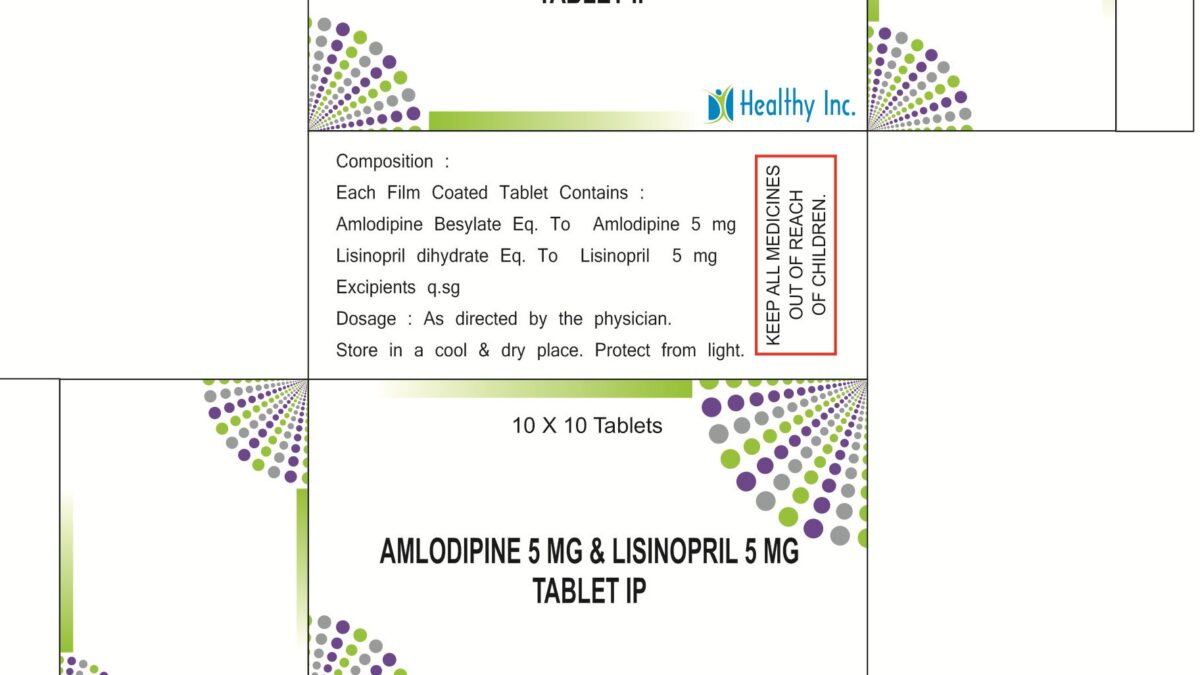Amlodipine + Lisinopril dehydrate Tablets Use

Amlodipine tablets Use
20/11/2023
Amlodipine + Enalapril maleate Tablets Use
20/11/2023Amlodipine + Lisinopril dehydrate Tablet manufacturer
Amlodipine and lisinopril are two different medications often used in combination to treat various cardiovascular conditions, such as hypertension (high blood pressure) and certain heart conditions. Amlodipine is a calcium channel blocker, while lisinopril is an angiotensin-converting enzyme (ACE) inhibitor. When prescribed together, they may be available in a combination tablet to provide more convenient dosing for patients.
Amlodipine helps to relax and widen the blood vessels, allowing blood to flow more easily and reducing blood pressure. It is particularly effective for treating hypertension.
Lisinopril, on the other hand, works by inhibiting an enzyme that constricts blood vessels and retains sodium and water, leading to decreased blood pressure.
Combining amlodipine and lisinopril can be beneficial in some cases, as it may provide a more comprehensive and effective approach to blood pressure control, especially when high blood pressure is challenging to manage with a single medication alone.
Please note that this is general information about these medications, and you should only take them under the supervision and guidance of a healthcare professional. They will determine the appropriate dosages and combinations based on your specific medical condition and needs. Additionally, it’s essential to follow your healthcare provider’s instructions and attend regular check-ups to monitor your condition and medication effectiveness.
Amlodipine and Lisinopril are two different medications that are sometimes prescribed together in a single combination tablet to treat high blood pressure (hypertension) or other cardiovascular conditions. Let me provide some information about each of these medications:
Amlodipine:Amlodipine is a calcium channel blocker. It works by relaxing and dilating blood vessels, making it easier for the heart to pump blood. This action helps reduce blood pressure and improve blood flow. It is often prescribed to treat hypertension and certain other heart-related conditions.
Lisinopril:Lisinopril is an angiotensin-converting enzyme (ACE) inhibitor. It relaxes blood vessels, reduces the workload on the heart, and is used to lower blood pressure. It is also prescribed for patients with heart failure or certain kidney conditions.
Combination tablets that contain both Amlodipine and Lisinopril are designed to provide the benefits of both medications in a single convenient form. This can be especially useful for people who require more than one type of medication to manage their blood pressure.
Please note that the specific formulation and dosages may vary depending on the pharmaceutical company that produces the combination tablet and the prescription provided by your healthcare provider. It’s important to take this medication exactly as prescribed and follow your healthcare provider’s instructions, as individual dosages and combinations can vary depending on your medical condition.
As with any medication, there may be potential side effects and interactions, so it’s crucial to discuss any concerns or questions you have with your healthcare provider or pharmacist. They can provide you with more detailed information about the specific Amlodipine and Lisinopril combination tablet you’ve been prescribed.
Amlodipine and Lisinopril are two different medications often prescribed together for the treatment of hypertension (high blood pressure) or other cardiovascular conditions. They work in different ways to lower blood pressure, and when used together, they can be more effective in managing hypertension than using either drug alone.
Amlodipine is a calcium channel blocker. It works by relaxing and widening the blood vessels, which makes it easier for the heart to pump blood and reduces blood pressure.
Lisinopril is an ACE (angiotensin-converting enzyme) inhibitor. It relaxes blood vessels and helps reduce blood pressure by inhibiting the production of a hormone that narrows blood vessels.
When combined, they can provide additive benefits in lowering blood pressure, and they are commonly prescribed as a fixed-dose combination in a single tablet. This combination can also help reduce side effects associated with high doses of a single medication.
It’s essential to take these medications only as prescribed by a healthcare professional and follow their instructions carefully. Also, consult with your healthcare provider if you experience any side effects or have questions about your treatment.
Amlodipine and Lisinopril are two different medications that are sometimes prescribed together for the management of certain medical conditions, particularly hypertension (high blood pressure). They are usually not combined in a single tablet, but they may be prescribed as separate medications. Let me provide some information on each of these medications:
Amlodipine:Amlodipine is a calcium channel blocker (CCB) that is used to treat high blood pressure and certain types of chest pain (angina). It works by relaxing blood vessels, making it easier for the heart to pump blood and reducing the workload on the heart.
Common brand names for amlodipine include Norvasc and others.
Amlodipine is usually taken orally in the form of tablets or capsules. Typical dosages vary and should be determined by your healthcare provider.
Lisinopril:Lisinopril is an angiotensin-converting enzyme (ACE) inhibitor. It is used to treat high blood pressure, heart failure, and other conditions. It works by relaxing blood vessels and reducing the body’s production of certain substances that can constrict blood vessels.
Common brand names for lisinopril include Prinivil and Zestril, among others.
Lisinopril is also taken orally in tablet form, and the specific dosage will depend on your medical condition and your healthcare provider’s recommendations.
If you have been prescribed both Amlodipine and Lisinopril, it’s important to follow your healthcare provider’s instructions carefully. These medications are often used in combination when one alone is not sufficient to control blood pressure. The combination can be more effective in some cases.
Please note that the specific dosage and usage instructions should be provided by your healthcare professional, as they will take into consideration your individual health status and any potential interactions or contraindications. Always follow their guidance and ask any questions you may have about your medications.


